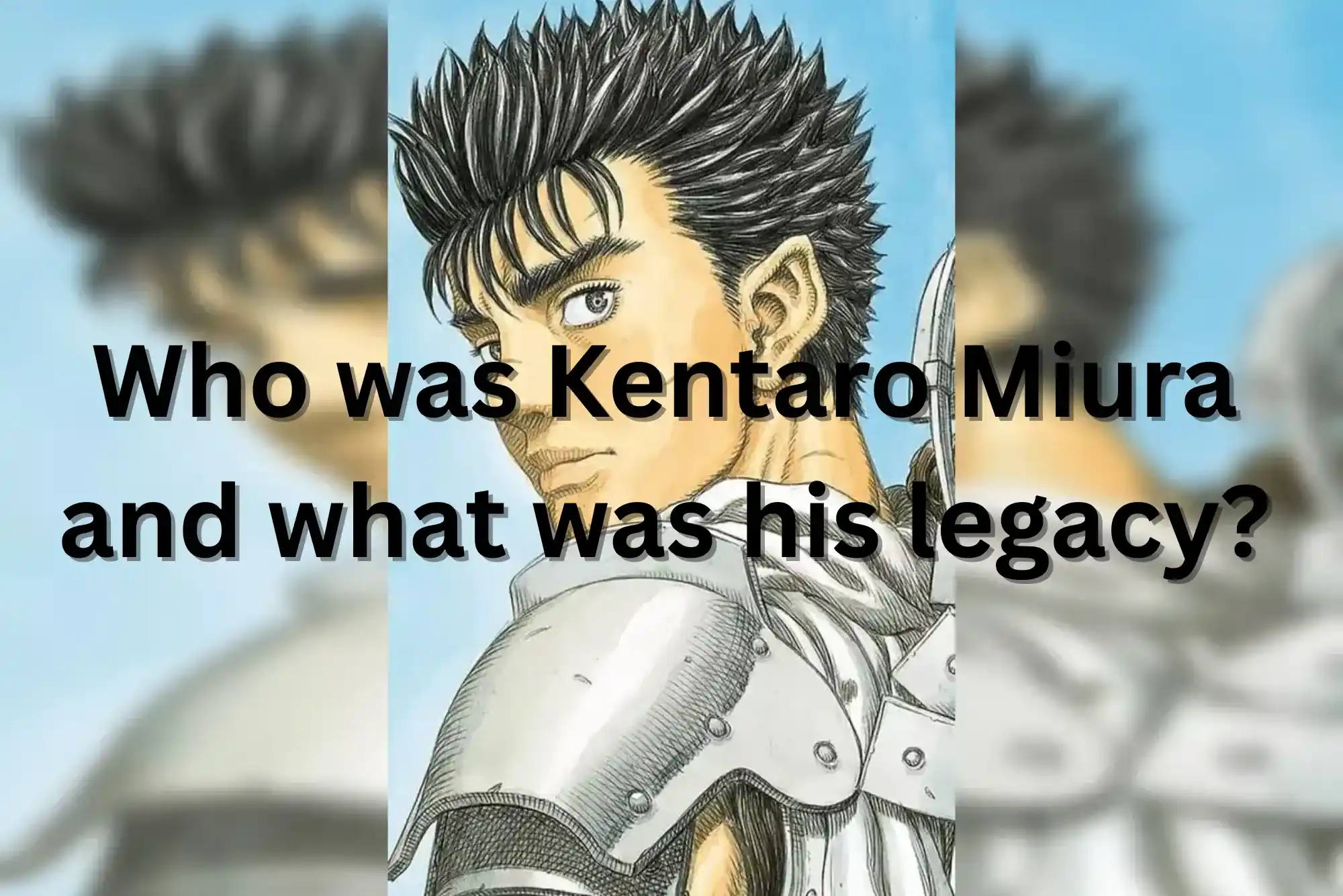Kentaro Miura was a visionary Japanese manga artist whose name is synonymous with the groundbreaking dark fantasy series Berserk. His work redefined the manga industry, blending intricate storytelling with breathtaking artwork to create a world that captivated millions. Miura’s untimely passing in 2021 left a void in the creative landscape, but his legacy endures through Berserk and its profound influence on manga, anime, and beyond. This article explores Miura’s life, his creative journey, and the indelible mark he left on the world of storytelling.
Early Life and Artistic Beginnings
A Young Prodigy’s First Steps
Born on July 11, 1966, in Chiba Prefecture, Japan, Kentaro Miura was surrounded by art from a young age. His parents, both artists—his father a storyboard creator for commercials and his mother an art teacher—fostered an environment that nurtured his creativity. At just 10 years old, Miura created his first manga, Miuranger, a 40-volume series for his classmates, showcasing an extraordinary talent for storytelling and illustration. This early work, though never formally published, hinted at the ambition and dedication that would define his career.
By 1977, Miura was experimenting with India ink in his second manga, Ken e no Michi (The Way to the Sword), marking a shift toward professional techniques. His middle school years saw further growth as he adopted rasters and honed his craft, laying the foundation for his future masterpieces. Miura’s early exposure to art and his relentless drive to improve set him apart as a prodigy destined for greatness.
High School and Formative Friendships
During high school, Miura enrolled in an artistic curriculum, where he met lifelong friend and fellow manga artist Kouji Mori. Together, they published works in school booklets and even co-authored a science fiction doujinshi submitted to Weekly Shōnen Sunday. Though it didn’t win, this collaboration strengthened Miura’s resolve to pursue manga professionally. At 18, he briefly worked as an assistant to George Morikawa, creator of Hajime no Ippo. Morikawa, recognizing Miura’s exceptional skill, famously dismissed him, stating there was nothing more he could teach the young artist.
In 1985, Miura’s submission of Futatabi (Once More) earned him admission to Nihon University’s art college and a nomination for Best New Author in Weekly Shōnen Magazine. These early achievements underscored his potential and set the stage for his most iconic creation: Berserk.
The Creation of Berserk
The Birth of a Dark Fantasy Epic
In 1988, Kentaro Miura introduced the world to Berserk: The Prototype, a 48-page one-shot published in Monthly ComiComi. This rough sketch of what would become Berserk featured Guts, a lone swordsman wielding a massive sword, navigating a brutal, medieval-inspired world. The prototype won a prize from the Comi Manga School, encouraging Miura to refine his vision. A year later, in 1989, Berserk began serialization in Hakusensha’s Monthly Animal House, later moving to Young Animal in 1992.
Berserk follows Guts, a scarred mercenary marked by the Brand of Sacrifice, and his quest for vengeance against Griffith, the charismatic leader of the Band of the Hawk. Set in a grim, medieval Europe-inspired world, the series tackles themes of fate, free will, and the human condition. Miura’s ability to weave complex narratives with visceral action and profound emotional depth made Berserk a standout in the seinen genre. By 2023, the series had over 60 million copies in circulation, cementing its status as one of the best-selling manga of all time.
Artistic Mastery and Storytelling
Miura’s artwork in Berserk is nothing short of legendary. His meticulous attention to detail—evident in every intricately drawn castle, grotesque demon, and battle-worn character—set a new standard for manga illustration. Fans and critics often compare his panels to the works of Renaissance painters like Hieronymus Bosch, noting their apocalyptic intensity and emotional weight. Miura’s use of shading, panel layout, and black-and-white balance created a gothic, wood-carving-like aesthetic that became Berserk’s signature.
Beyond its visuals, Berserk’s storytelling is equally compelling. Miura was a discovery writer, often crafting the narrative without a rigid plan, allowing characters like Guts and Casca to evolve organically. The Golden Age arc, which chronicles Guts’ early life and the tragic Eclipse, is widely regarded as one of manga’s greatest story arcs. Miura’s ability to balance relentless darkness with moments of hope, love, and camaraderie resonated deeply with readers, making Berserk a profound exploration of the human spirit.
Influences and Inspirations
Drawing from Diverse Sources
Kentaro Miura’s creative process was shaped by a wide array of influences. He drew heavily from manga like Fist of the North Star by Buronson and Tetsuo Hara, as well as Go Nagai’s Violence Jack. The Guin Saga, a Japanese fantasy novel series, inspired Guts’ iconic Dragonslayer sword, while shōjo manga influenced the delicate emotional moments in Berserk. Miura also cited Western media, including Paul Verhoeven’s films, the Hellraiser series, and European fairytales, as key inspirations for the series’ grim tone and fantastical elements.
Artists like M.C. Escher, Gustave Doré, and Pieter Bruegel influenced Miura’s visual style, evident in the surreal and haunting imagery of Berserk’s demonic realms. His settings, inspired by French and Spanish medieval architecture, brought a tangible sense of place to the manga’s world. Miura’s ability to synthesize these diverse influences into a cohesive, original work showcased his genius as both an artist and a storyteller.
Collaborations and Early Works
Before dedicating himself to Berserk, Miura collaborated with Buronson on King of Wolves (1989) and Japan (1992), both serialized in Monthly Animal House. These projects honed his ability to blend intense action with rich world-building. Later, he explored new ideas in Gigantomakhia (2013) and Duranki (2019), the latter produced with his Studio Gaga team. While these works showcased Miura’s versatility, none matched the cultural impact of Berserk.
Kentaro Miura’s Legacy
A Lasting Impact on Manga and Beyond
Kentaro Miura’s sudden death on May 6, 2021, from an acute aortic dissection at age 54 shocked the global manga community. His passing left Berserk unfinished, with the posthumous 364th chapter published in September 2021. However, Miura’s legacy extends far beyond his magnum opus. Berserk inspired countless creators, influencing manga like Attack on Titan, Fullmetal Alchemist, and Jujutsu Kaisen. Its impact is also evident in video games, with titles like Dark Souls, Final Fantasy, and Bloodborne bearing clear homages to Miura’s dark fantasy aesthetic.
Miura’s friend Kouji Mori and Studio Gaga have continued Berserk since June 2022, using Miura’s notes and memoranda to guide the series toward its intended conclusion. Mori, who knew Miura’s planned ending, has vowed to honor his vision without adding personal embellishments. This continuation reflects the deep respect for Miura’s work and ensures that Berserk remains a living testament to his genius.
Awards and Recognition
In 2002, Miura received the Award for Excellence at the sixth Tezuka Osamu Cultural Prize, a testament to Berserk’s critical acclaim. The series’ commercial success, with over 60 million copies sold by 2023, underscores its global reach. Fans have celebrated Miura’s ability to blend breathtaking art with profound storytelling, often describing Berserk as a work of art worthy of museum display. The Big Berserk Exhibition in Tokyo in 2021, featuring over 300 of Miura’s artworks, further highlighted his enduring influence.
A Personal Legacy
Miura was a private individual, rarely giving interviews or appearing in public. Yet, his dedication to his craft was evident in every page of Berserk. Known for doing much of the work himself, with assistants primarily aiding with backgrounds, Miura poured his heart into his art. His fans, while joking about the series’ slow release schedule, admired his perfectionism and commitment to quality. Miura’s ability to create complex, relatable characters like Guts—a man torn between vengeance and humanity—resonated with readers worldwide.
Why Kentaro Miura’s Work Endures
A Universal Story of Struggle
At its core, Berserk is about the human struggle against fate, a theme that transcends cultural boundaries. Guts’ relentless fight against insurmountable odds mirrors the resilience Miura sought to inspire in his readers. The series’ exploration of trauma, betrayal, and redemption speaks to universal human experiences, making it timeless. Miura’s willingness to confront dark themes while offering glimmers of hope created a narrative that feels both harrowing and uplifting.
Influence on Modern Media
Miura’s legacy extends to anime, with Berserk adapted into series in 1997 and 2016, though neither fully captured the manga’s visual splendor. The series also spawned merchandise, from statues to trading card games, and influenced video game design, with Dark Souls creator Hidetaka Miyazaki citing Berserk as a key inspiration. Miura’s work continues to shape the dark fantasy genre, proving that a single artist’s vision can ripple across mediums.
A Community United by Art
The Berserk fandom remains a vibrant community, united by their love for Miura’s work. Social media platforms like Reddit and X buzz with discussions about Guts’ journey, Miura’s artistry, and the series’ future. Fans share tributes, artwork, and analyses, keeping Miura’s spirit alive. The outpouring of grief following his death in 2021 underscored the deep connection readers felt with his work, with many describing Berserk as a life-changing experience.
Conclusion
Kentaro Miura was more than a manga artist; he was a storyteller who crafted a world that challenged and inspired millions. Through Berserk, he explored the depths of human emotion, blending unparalleled artistry with narratives that resonate across generations. His legacy lives on in the continued publication of Berserk, the creators he inspired, and the fans who carry his story forward. Miura’s work reminds us that even in the darkest of worlds, the struggle for meaning and hope endures.




